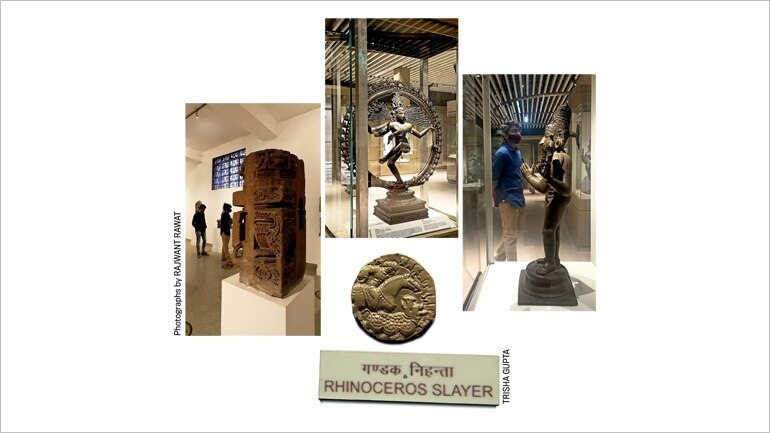
[ad_1]
The National Museum New Delhi had never felt this intimate. I was in the Miniature Gallery when a robust male voice began to sing loudly: “Tu hi pyaar, tu hi chaahat, tu hi aashiqui hai”. I had been admiring Radha and Krishna admiring their own reflection in a mirror: a pre-digital couplefie aided by an attendant, and the painter. Now the 1640 Mewar miniature seemed illuminated by the security guard’s rendition of the song from Mahesh Bhatt’s 1990 romantic superhit, Aashiqui.
It was 3 pm on the first Sunday after India’s premier museum reopened on November 10, but only 23 ticketed visitors before me had entered the grand old building on New Delhi’s Janpath. Inaugurated in 1960, the museum complex is being revamped since 2017, and I have often found the upper floors closed for renovation.
On Sunday, you could again climb the grand staircase to the second floor, but the only gallery open was ‘Tribal Lifestyle of North East India’: unreconstructed old-style anthropology running rampant, though there are some striking Monpa and Naga masks and headdresses. Sections of the open corridor display were cordoned off, but visitors might enjoy the 10th century South Indian stone sculptures of zodiac signs. On the first floor, I followed two reluctant men into the Ajanta Paintings gallery at a guard’s urging, but the lights were all off. Tanjore Paintings, too, was closed. But you could visit Central Asian Antiquities, Maritime Heritage and the Coins Gallery, which I have always thought an attractively condensed history of South Asia. Watch out for the 3rd-5th century CE Gupta emperors, who chose this most public canvas to enshrine themselves in the popular imagination as ‘Rhinoceros-slayer’, ‘Swordsman’ and my favourite, ‘Lyrist’: the conqueror Samudragupta proclaiming his mastery of the veena. Post-demonetisation currency isn’t a patch on Gupta coinage.

National Treasures (from left) ‘Pillar with Purna Kumbha’ (12th century AD), ‘Nataraja’, the lord of dance (12th century CE), ‘Nandikesvara’ (15th century CE), and (below) a Gupta-era coin depicting the emperor as a rhinoceros-hunter, all on display atthe National Museum, Delhi
On the ground floor, I paid a visit to the Harappan Dancing Girl, tiny and insouciant as ever, before ambling into the sculptures, where a stunning buffalo-headed female figure caught my eye. “Vrishanana Yogini. Pratihara, 10th -11th cent. A.D. Lokhari, Distt. Banda, Uttar Pradesh,” said the label. It was only later that the internet told me this was one of the museum’s most treasured new acquisitions. Illegally trafficked out of an Uttar Pradesh temple, this example of the powerful female-centric Yogini cult was returned to the Indian embassy in Paris in 2008 by the widow of a French collector and acquired by the museum in 2013, under the then director general, Venu V. If only our curators understood: this is the story that should be on the plaque. The nation would want to know.
“Sixteen of the museum’s 27 galleries are accessible in this first phase of reopening,” the museum’s education officer Rige Shiba wrote in an email. Many new arrangements are in place: the ticket counter is now outside the entry gate to the complex, and temperature checks, sanitisation and security screening take place before you walk in. Following the ministry of culture’s guidelines for post-Covid reopening, free volunteer-led tours are currently suspended. So is one of the museum’s innovations for visually-disabled visitors: touch tours of the 22-item Anubhav gallery. Audio guides are also out for the moment “unless these can be disinfected after every single use”.
Curatorial tours are also suspended at the National Gallery of Modern Art (NGMA), where daily ticketed visitors are down from 250-500 in pre-Covid times to about 70. The gallery is discouraging group visits, with curators offering customised digital walkthroughs instead. There’s also a free virtual tour. But on Sunday evening, having scurried through November rain, I could not have found happier shelter than the beauteous airy interiors of the NGMA. Anupam Sud’s Ceremony of Unmasking triptych made me smile at its new relevance. Bhupen Khakhar’s miniature-inspired Hamam Khana (1982) seemed prescient about our strange faux-sanitised times: a naked woman standing rigidly to attention in a bare, controlled enclosure, as if waiting to be allowed to bathe.
I took the empty elevator upstairs, discovering the Mexican mural-like joys of Pran Nath Mago’s Rice Planters (1952), before arriving at his Delhi Shilpi Chakra collective contemporary, the underrated modernist B.C. Sanyal (1901-2003). I stood forever in front of Sanyal’s stunning At the Nizamuddin Fair and his seductively lungi-clad self-portrait, Old Man and the Bird. “Now that’s the old man of love to become,” a friend texted back.
A masked boy and girl stopped at an M.F. Husain. “Yeh Picasso hain (this is a Picasso),” the boy said. “Kehte hain inki chai bhi gir jaati thi, toh painting ban jaati thi (they say if he dropped his tea, it would also become a painting).” They held hands tightly. The world fell away.
[ad_2]
Source link